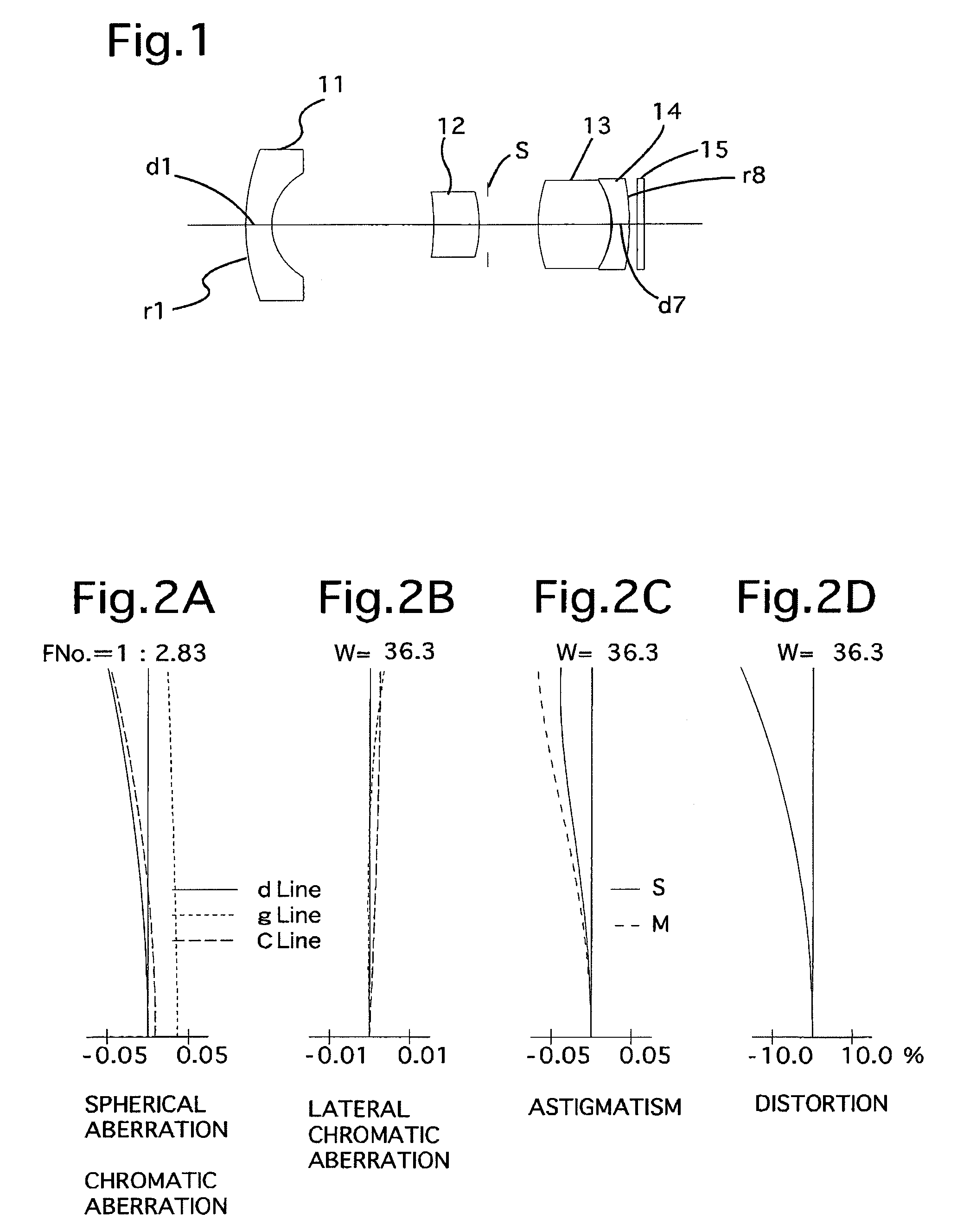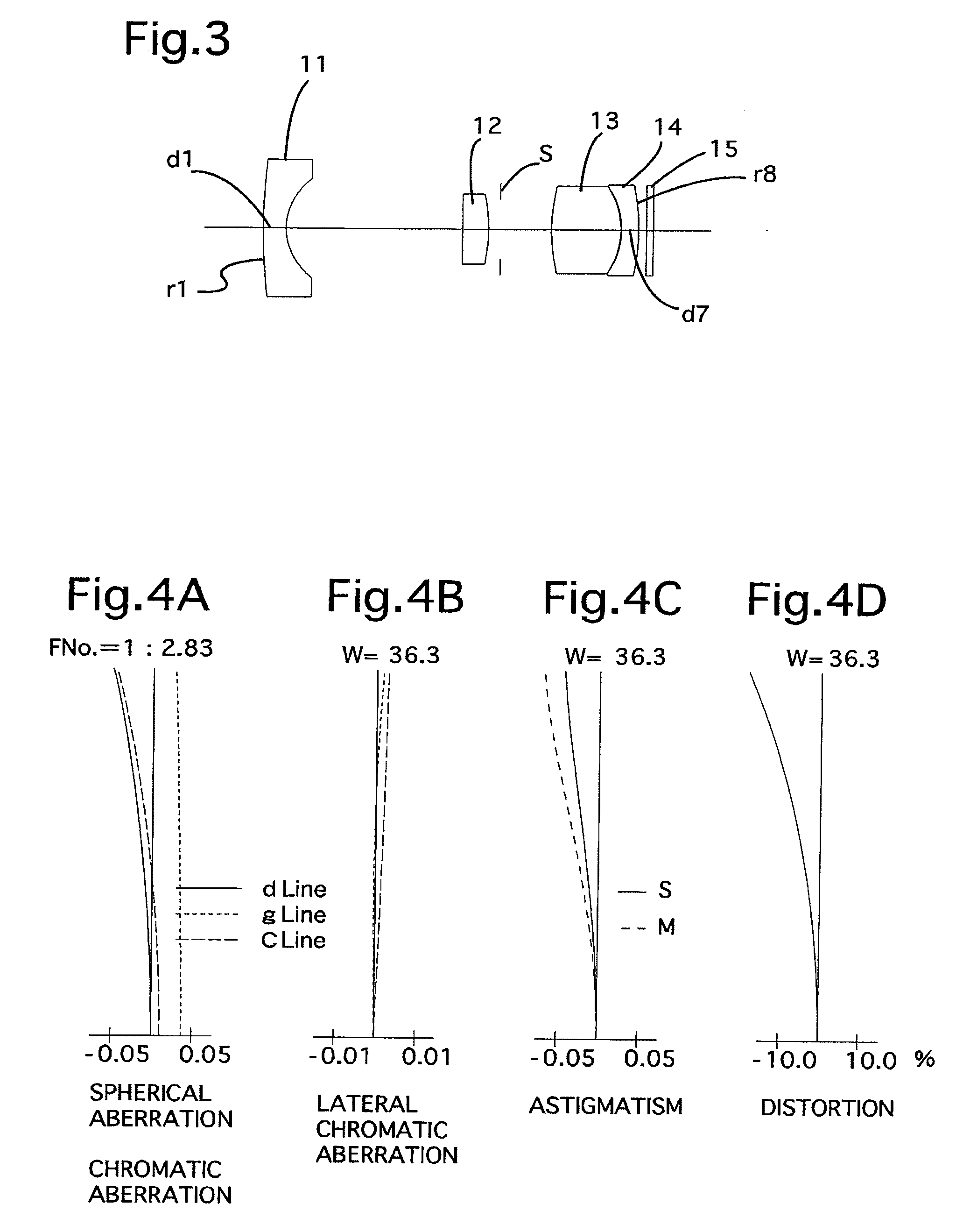Wide-angle lens system
a wide-angle lens and wide-angle technology, applied in the field of wide-angle lens systems, can solve the problems of insufficient chromatic aberration correction, inability to use conventional wide-angle lens systems in in-vehicle sensor cameras, and inability to supply in-vehicle sensors at a lower pri
- Summary
- Abstract
- Description
- Claims
- Application Information
AI Technical Summary
Benefits of technology
Problems solved by technology
Method used
Image
Examples
embodiment 1
[0158]FIG. 1 is the lens arrangement of the wide-angle zoom lens system according to the first embodiment of the present invention. FIGS. 2A through 2D show aberrations occurred in the lens arrangement shown in FIG. 1. Table 1 shows the numerical data of the first embodiment.
[0159]The wide-angle lens system includes the negative first meniscus lens element 11 having the convex surface facing toward the object, the positive second lens element 12 having the convex surface facing toward the image, the diaphragm S, the positive third biconvex lens element 13, the negative fourth meniscus lens element 14 having the convex surface facing toward the image, and the cover glass 15 (thickness=0.4, Nd=1.51633, v=64.1; the same for all embodiments) provided in front of an imaging device, in this order from the object.
[0160]The numerical data in the Tables does not include that of the cover glass 15 (i.e., the value of fB does not include the cover glass 15; the same for all embodiments).
[0161]...
embodiment 2
[0162]FIG. 3 is the lens arrangement of the wide-angle zoom lens system according to the second embodiment of the present invention. FIGS. 4A through 4D show aberrations occurred in the lens arrangement shown in FIG. 3. Table 2 shows the numerical data of the second embodiment.
[0163]The basic lens arrangement of the second embodiment is the same as that of the first embodiment except that the positive second lens element 12 is constituted by a planoconvex lens element having the object-side flat surface.
[0164]The diaphragm S is provided 0.670 behind the second lens element 12 (surface No. 4).
TABLE 2FNO = 1:2.83f = 4.57W = 36.3fB = 8.27Surf. No.rdNdNtν139.8281.301.589131.5781461.224.11110.173∞1.511.785901.7670244.24−11.6343.62512.7483.931.741001.7252452.76−5.4520.067−5.3001.001.922861.8780718.98−13.823—
embodiment 3
[0165]FIG. 5 is the lens arrangement of the wide-angle zoom lens system according to the third embodiment of the present invention. FIGS. 6A through 6D show aberrations occurred in the lens arrangement shown in FIG. 5. Table 3 shows the numerical data of the third embodiment.
[0166]The basic lens arrangement of the third embodiment is the same as that of the first embodiment except that the positive second lens element 12 is constituted by a biconvex positive lens element.
[0167]The diaphragm S is provided 0.500 behind the second lens element 12 (surface No. 4).
TABLE 3FNO = 1:2.83f = 4.57W = 36.3fB = 7.48Surf. No.rdNdNtν1154.1991.301.658441.6444650.924.49910.28317.3251.551.755001.7389352.34−17.3253.91512.1884.321.658441.6444650.96−4.6680.027−4.6241.001.922861.8780718.98−12.161—
PUM
 Login to View More
Login to View More Abstract
Description
Claims
Application Information
 Login to View More
Login to View More - R&D
- Intellectual Property
- Life Sciences
- Materials
- Tech Scout
- Unparalleled Data Quality
- Higher Quality Content
- 60% Fewer Hallucinations
Browse by: Latest US Patents, China's latest patents, Technical Efficacy Thesaurus, Application Domain, Technology Topic, Popular Technical Reports.
© 2025 PatSnap. All rights reserved.Legal|Privacy policy|Modern Slavery Act Transparency Statement|Sitemap|About US| Contact US: help@patsnap.com



